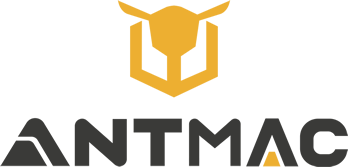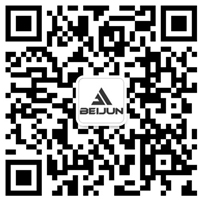Comprehensive Safety Operation Guide for Spider Boom Cranes
Spider boom cranes (spider lifts), renowned for their high flexibility and site adaptability, are widely used in construction, power maintenance, interior decoration, and other scenarios. However, high-altitude lifting operations involve significant risks and strict technical requirements, making standardized operation and safety management critical. This guide integrates international safety standards and industry best practices to provide end-to-end safety guidelines—from pre-operation preparations and work procedures to maintenance and emergency response—applicable to all types of spider boom cranes. It aims to help users achieve "zero-accident" operations.
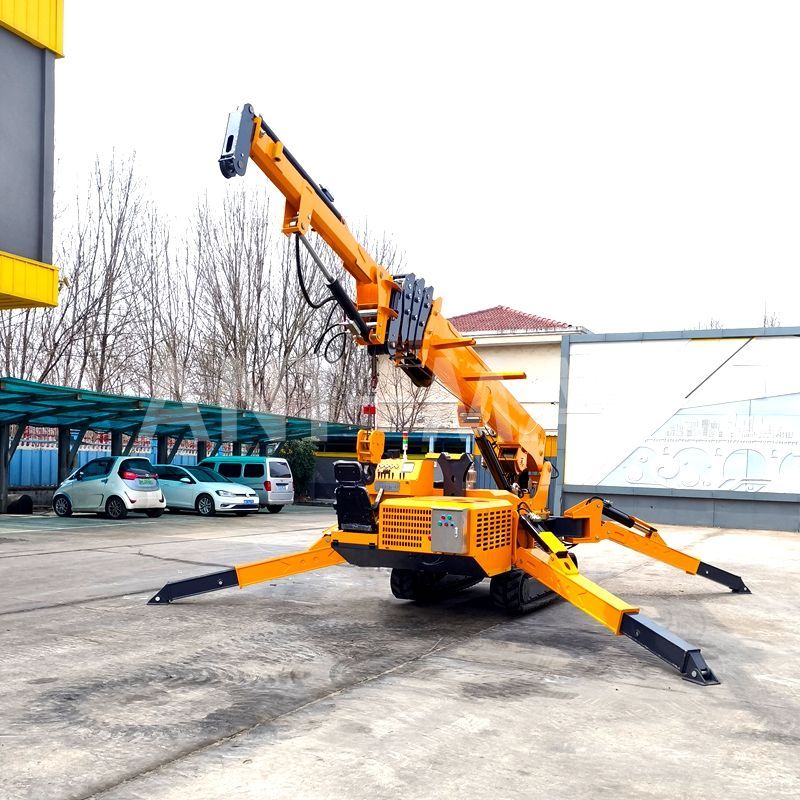
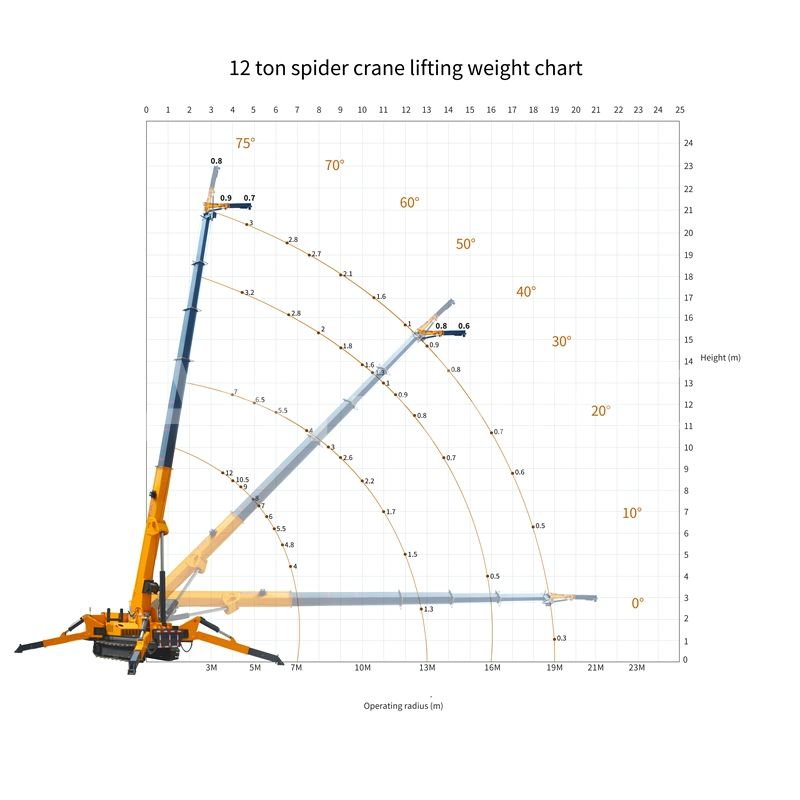
I. Pre-Operation Preparations: Three Inspections and Three Tests for Equipment Readiness
1. Environmental and Foundation Checks
Outrigger Support Requirements:
The ground must be flat and stable, with bearing capacity meeting equipment specifications (reinforce with steel plates or roadbed boards if necessary), and slope controlled within a safe range.
Outriggers must be fully extended and locked. Use a spirit level to ensure even load distribution.
Weather Restrictions:
Operations are prohibited under adverse weather conditions (e.g., strong winds, heavy rain, low visibility).
In rainy or snowy weather, check track/tire anti-slip performance and take necessary measures (e.g., install anti-skid chains).
2. Equipment Function Testing
No-Load Test Run:
After starting the engine, check instrument readings (oil pressure, voltage, alarm indicators).
Test outrigger extension/retraction, boom lifting/extension, and slewing mechanism to ensure smooth operation without 卡顿 (jams) or abnormal noise.
Verify the functionality of safety devices (overload limiter, emergency stop button, limit switches).
3. Personnel Qualifications and Coordination
Operators must hold valid special operation certificates and be familiar with the equipment manual.
For multi-person operations, designate a signal person (with visible identification) and use standardized hand signals or two-way radios for communication (single channel, no unrelated communication).
II. Full-Procedure Specifications for Lifting Operations
1. Load Calculation and Balance
Overloading Strictly Prohibited:
Total load (cargo + lifting gear) must not exceed the equipment’s rated lifting capacity.
Center of gravity offset must be controlled within the equipment’s designed allowable range to avoid imbalance risks.
2. Boom Operation Precautions
Extension and Slewing Principles:
Boom extension/retraction must be performed when the equipment is stationary; never operate while moving.
Slew at low speed (control speed as per equipment requirements) and decelerate in advance when approaching obstacles.
Adjust boom angle reasonably based on load weight to avoid instability caused by excessive steepness.
3. Movement and Positioning
Low-Speed Movement Rules:
For short distances, use track/tire movement; for long distances, transport via flatbed trucks.
Retract the boom to its minimum amplitude during movement and avoid obstacles like cables and ditches.
Turn radius must comply with equipment specifications to prevent sharp turns and rollovers.
III. Risk Management for Special Scenarios
1. Narrow-Space Operations
Expand outrigger support area (use auxiliary outriggers/padding blocks) and remove track side guards if necessary.
Use surveillance cameras for auxiliary observation to maintain a safe distance between the boom and obstacles.
2. Night/Limited Visibility Operations
Turn on work lights and warning beacons, and set up reflective isolation barriers on the ground.
Pause operations every 10 minutes to confirm personnel positions; no blind operation is allowed.
3. Temporary Shutdown Procedures
Raise the hook to a safe height, turn off the engine, and secure the key.
In adverse weather, use additional fixing measures (e.g., connect the equipment to ground anchors with steel wires).
IV. Safety Devices and Maintenance
1. Protection of Core Safety Devices
Prohibited Actions:
Do not bypass or tamper with safety devices (e.g., overload limiters, limit switches).
Regularly inspect wire rope wear (replace if broken wires exceed the safe allowable range) and lubricate pulleys (apply grease as per the equipment manual).
2. Regular Maintenance and Servicing
Daily Maintenance: Inspect appearance, fasteners, and lubrication points before/after operations; clean the equipment.
Periodic Maintenance: Tighten connection components and apply lubricant monthly/quarterly; inspect wear and tear on vulnerable parts.
Function Testing: Test safety device sensitivity and operational functionality semi-annually/annually.
Record-Keeping: Maintain detailed maintenance logs with timestamps, tasks, and issue notes for equipment status tracking.
V. Emergency Response and Accident Prevention
1. Sudden Fault Handling
Hydraulic Pipe Burst: Press the emergency stop button immediately, use a backup manual pump to retract the boom, and never repair under pressure.
Power Failure: Switch to emergency battery mode, manually retract outriggers, and contact professional technicians for repairs.
2. Overturning Risk Warning
In case of abnormal shaking or outrigger sinking, stop operations immediately and evacuate personnel to a safe area (≥5m away).
For minor tilting (<5°), balance with symmetrically loaded counterweights (e.g., sandbags); for severe tilting, use professional lifting equipment for correction.
VI. Long-Term Safety Management Mechanisms
1. Operation Records and Review
Record daily operation data (working hours, fault codes, load values, etc.).
Conduct monthly case analysis meetings (including near-miss incidents) to optimize operation procedures.
2. Regulatory Compliance and Personnel Qualifications
Equipment must undergo regular safety performance inspections and comply with local regulations and industry standards.
Operators must pass professional training and assessments, participate in refresher training every two years (covering safety protocols, new technology applications, and emergency drills), and retain training records.
The safe operation of spider boom cranes relies on strict adherence to standardized procedures, continuous maintenance, and effective safety management. Every meticulous pre-operation inspection and precise operational step is crucial for safeguarding lives and equipment stability. We urge all industry practitioners to prioritize "safety first" and uphold professional standards to protect every moment of high-altitude operations.
There are no shortcuts to safety—standardization ensures foolproof protection.
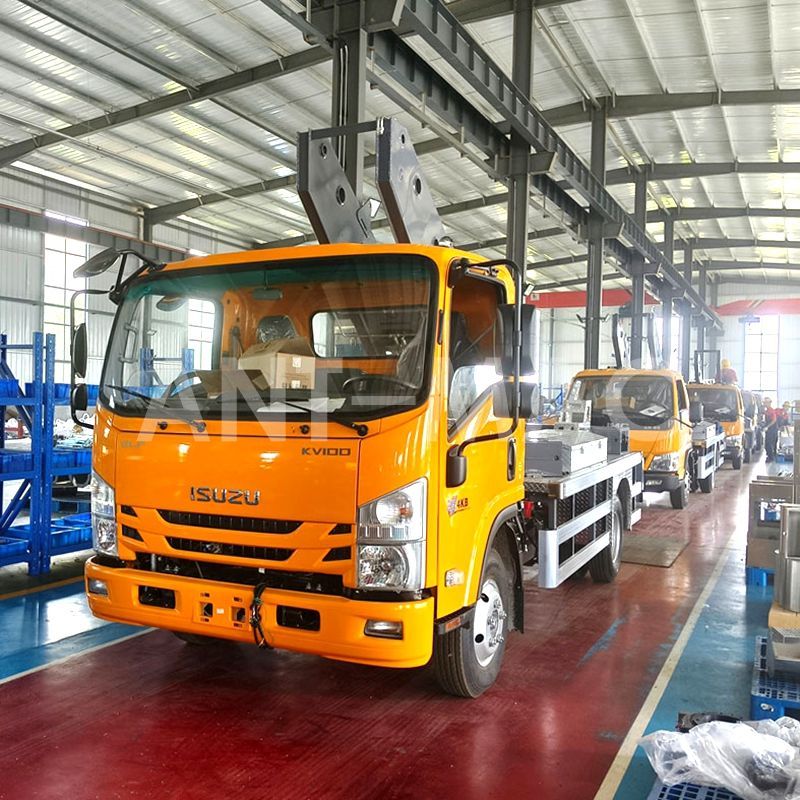 Dual-Chain Telescopic Boom Sys
Dual-Chain Telescopic Boom Sys
 Russian
Russian